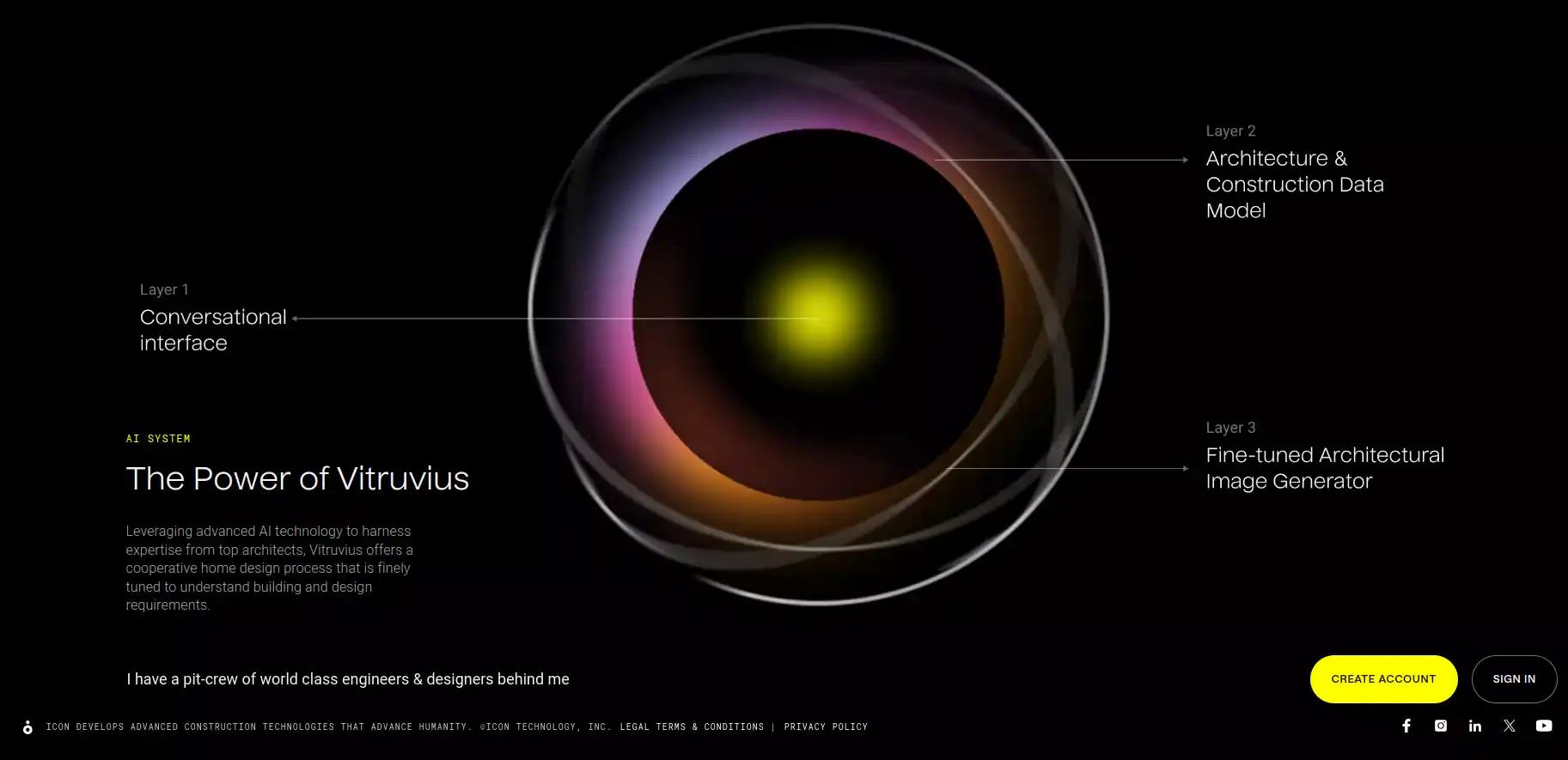Table of Contents
Artificial intelligence (AI) is revolutionizing various industries, and now it’s making its way into the housing space, specifically architecture. Imagine a program that can design your dream home, taking your desires and turning them into detailed plans—all within seconds. Enter Vitruvius AI, an innovative solution developed by ICON, the company behind one of the first fully 3D-printed housing developments in the U.S.
The Vision of Vitruvius

Vitruvius is more than just a home design tool; it represents a paradigm shift in how we approach architecture and construction. To understand its vision, let’s break down Jason Ballard’s statement:
- Human Desire: At the heart of every home design project lies human desire—the dream of a perfect living space. Whether it’s a cozy cottage, a sprawling mansion, or a minimalist urban loft, our desires shape the vision for our homes.
- Streamlining the Process: Traditionally, the journey from desire to a fully realized home involves multiple stages: conceptualization, planning, architectural design, engineering, permits, construction, and delivery. Each step can be time-consuming, costly, and prone to inefficiencies.
- Vitruvius’s Ambition: Vitruvius aims to simplify this complex process. It wants to be there from the very beginning—when you first imagine your dream home—to the final delivery of construction plans. Imagine a seamless flow where your desires translate effortlessly into tangible designs.
- Conceptualization: Vitruvius starts by asking you questions about your ideal home. Where will it be located? How big should it be? What architectural style resonates with you? These inputs form the foundation of the design process.
- Learning and Adaptation: Vitruvius doesn’t stop there. It learns from your answers and draws from its vast database of building codes, construction methods, and structural engineering principles. It adapts, refines, and generates design proposals based on this knowledge.
- Design Proposals: Within seconds, Vitruvius presents you with three potential home designs. These aren’t generic templates; they’re tailored to your preferences and the practical constraints of the real world.
- Beyond the Basics: But Vitruvius doesn’t stop at the basics. It can show you how your home would look if it were 3D printed or if it followed the style of a renowned architect. It’s like having an AI-powered architectural tour.
Understanding What’s Possible
Vitruvius is no ordinary design tool. It’s been trained in building codes, construction methods, and structural engineering principles. As a result, it understands what’s feasible and what isn’t. It far exceeds human capability in terms of recalling designs and possibilities it has encountered.
How Vitruvius Works
- User Input: The process begins when a user types in a general idea of the type of house they’d like to build. It could be anything—a cozy cottage, a modern mansion, or a minimalist urban dwelling.
- Inquisitive AI: Vitruvius then starts asking questions. Where will the home be located? How large should it be? What architectural style appeals to you? Which amenities are essential? These questions help Vitruvius understand your preferences.
- Learning from Answers: Vitruvius learns from your answers and incorporates knowledge from past designs. It adapts and refines its suggestions based on your input.
- Design Proposals: The magic happens next. Vitruvius generates designs for three potential homes. Each design takes into account your preferences, local regulations, and structural requirements.
- Visual Exploration: But that’s not all. Vitruvius can also show you what your home would look like if it were 3D printed or if it followed the style of a famous architect—whether living or deceased. It’s like having an AI-powered architectural tour.
Addressing Copyright Concerns
Some might worry about copyright infringement, especially when AI models generate designs inspired by existing works. However, Ballard reassures us: “It’s not actually stealing anyone’s actual work. It’s just sort of taking inspiration in the way that human artists take inspiration.” Vitruvius respects creativity while avoiding legal pitfalls.
Real-World Testing
Vitruvius made its debut at the South by Southwest festival in Austin, Texas. Real estate agents and architects alike tried it out. Leonardo Guzman, an architect and builder, believes that AI will become a valuable tool, transforming the field of architecture. Gina McAndrews, a real estate agent, was impressed by Vitruvius but expects it to complement architects rather than replace them.

Affordable Housing and Beyond
Beyond individual consumers, Vitruvius has broader implications. Ballard sees it as a game changer for affordable housing. Often, affordable housing projects compromise on architectural beauty due to budget constraints. Vitruvius can change that. As Ballard puts it, “Even affordable housing projects deserve beauty and dignity.” Over time, the cost of using this tool should approach the cost of powering the system—an exciting prospect for accessible, well-designed homes.
FAQ: Vitruvius AI
- Is Vitruvius AI accessible to everyone?
- Yes! Vitruvius AI aims to democratize home design by making it more affordable and efficient.
- Can I use Vitruvius AI for commercial projects?
- Absolutely. Vitruvius AI isn’t limited to residential designs. It can assist with commercial and community projects too.
- What if I want a unique design not based on existing styles?
- Vitruvius AI encourages creativity. If you have a unique vision, it will work with you to bring it to life.
- How accurate are the cost estimates provided by Vitruvius AI?
- Vitruvius AI considers material costs, labor, and other factors. While estimates are reliable, consulting with professionals is still recommended.
- Will Vitruvius AI replace architects entirely?
- Unlikely. Vitruvius AI enhances efficiency, but human expertise remains invaluable in refining designs and addressing complex challenges.